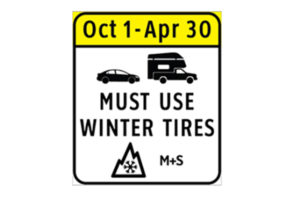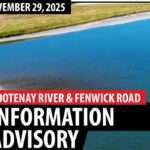Home »

It is winter tires time
B.C. law requires drivers to use winter tires on most highways starting October 1. Safety experts say that checking your tires before installation is just as important as putting them on.
“Winter tires are only as good as their condition,” said Trace Acres, spokesperson for Road Safety at Work’s annual Winter Driving Safety campaign. “Worn or damaged tires can be just as dangerous as no winter tires at all.”
The law requires a minimum tread depth in winter of 3.5 mm. Tires also must be in good condition. Cracks, bulges, missing chunks, or uneven wear are all signs that a tire should be replaced or inspected by a technician.
“A few minutes checking tread and condition can make the difference between stopping safely and sliding into a crash,” Acres said.
 Traction can be in short supply during early fall, when sudden cold snaps, frost, and even snow often catch drivers off guard. All-season tires lose effectiveness when temperatures drop below 7C — long before the first snowfall.
Traction can be in short supply during early fall, when sudden cold snaps, frost, and even snow often catch drivers off guard. All-season tires lose effectiveness when temperatures drop below 7C — long before the first snowfall.
“Winter weather doesn’t wait for the calendar, and neither should drivers,” Acres said.
Provincial law requires vehicles to be equipped with winter tires when travelling on most highways from October 1 through March 31, and until April 30 on select mountain passes and high-snowfall routes. The law applies to passenger vehicles and light trucks, whether they are two-wheel, all-wheel, or four-wheel drive.
If you already own winter tires, Road Safety at Work advises booking an installation appointment now before tire shops are overwhelmed with demand.
If you’re buying winter tires, know that they’re not all created equal.
Tires with “M+S” (mud and snow) on the sidewall meet the minimum B.C. legal standard. But in snowy and cold conditions, Road Safety at Work recommends tires with the three-peaked mountain and snowflake symbol on the sidewall, which meet a higher winter performance standard than basic M+S tires.
Whichever tires you use, make sure they’re properly inflated. Correct pressure is key to traction, and tire pressure naturally drops in cool weather.
For the hundreds of thousands of B.C. residents who drive on the job, injury claims from work-related crashes go up roughly 20% in winter, according to WorkSafeBC statistics.
Work driving includes everything from making deliveries, to driving to meetings, to calling on clients, to running business errands. A vehicle used for work is deemed a workplace.
Employers are responsible for employee safety behind the wheel, even when drivers use their personal vehicles for work. Employees are responsible for knowing and following their employer’s winter driving rules.
Employers must ensure that employees are properly trained, educated, and know the organization’s policies and procedures for winter driving. Workers are encouraged to speak with their employer if they are unsure about winter driving — ideally, before the snow starts to fall.
Road Safety at Work’s annual Winter Driving Safety campaign is a provincial awareness campaign funded jointly by WorkSafeBC, ICBC, and the Ministry of Transportation and Transit. It is supported by the Road Safety at Work Alliance.
For more tips on winter driving safety, visit RoadSafetyAtWork.ca/Winter.
e-KNOW file photo
Road Safety at Work







